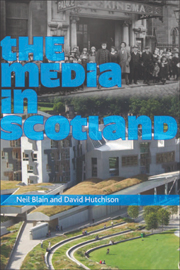Book contents
- Frontmatter
- Contents
- Preface
- Framing the Discussion
- The Historical Context
- Screen and Sound
- Themes and Futures
- 12 Gender, Spaces, Changes: Emergent Identities in a Scotland in Transition
- 13 Race and Ethnicity in the Media
- 14 Gaelic, the Media and Scotland
- 15 The Scottish Media and Politics
- 16 A View from Westminster
- 17 A View from Holyrood
- 18 Media Sport
- Select Bibliography
- Notes on Contributors
- Index
14 - Gaelic, the Media and Scotland
from Themes and Futures
Published online by Cambridge University Press: 05 August 2013
- Frontmatter
- Contents
- Preface
- Framing the Discussion
- The Historical Context
- Screen and Sound
- Themes and Futures
- 12 Gender, Spaces, Changes: Emergent Identities in a Scotland in Transition
- 13 Race and Ethnicity in the Media
- 14 Gaelic, the Media and Scotland
- 15 The Scottish Media and Politics
- 16 A View from Westminster
- 17 A View from Holyrood
- 18 Media Sport
- Select Bibliography
- Notes on Contributors
- Index
Summary
When Headlines: The Media in Scotland was published in 1978, Gaelic received only the most fleeting of mentions (Hutchison 1978). This was not surprising given the minimal amount of the language on television, and the merest outline of a radio service (see Cormack 1993 for an account of Gaelic broadcasting before the 1990s). Since then, however, much has changed in the Scottish media, and Gaelic provision is no exception. This chapter describes the changes and sets them in the international context of minority language media. In doing so, it seeks answers to two questions: How important are the media to Gaelic? How important are the Gaelic media to Scotland?
MINORITY LANGUAGE MEDIA
Since the 1980s, minority language media have gradually emerged as significant parts of provision, particularly in Europe. The inception of television channels in Welsh, Basque and Catalan in the early 1980s marked this change. There had, of course, been minority language media in earlier times and in other places (see Browne 2007 for a short general history), but in the European context it was the development of television in the Celtic languages and the Iberian ‘regional’ languages that most firmly put the issue on the map. Before then, minority languages were typically regarded either with complete distrust or with a condescending paternalism. That paternalism was evident at the BBC. The Corporation's Handbook of 1942 noted that ‘For the Highlander there were the regular weekly broadcasts in his native tongue – the news and a postscript in Gaelic’ (BBC 1942: 31).
- Type
- Chapter
- Information
- The Media in Scotland , pp. 213 - 226Publisher: Edinburgh University PressPrint publication year: 2008

